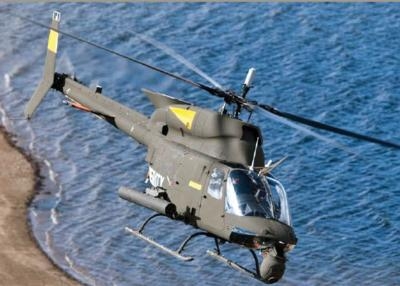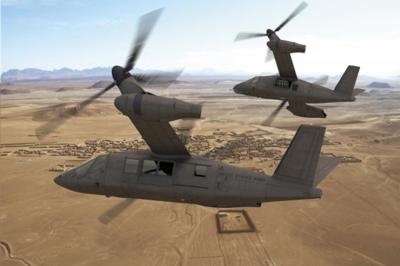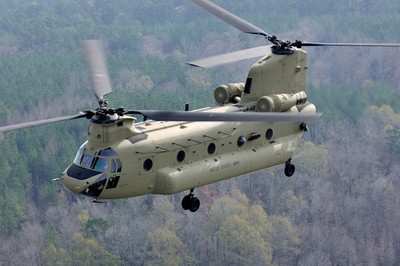Russian Helicopters Projected To Lead In Unit Production
An estimated 4,791 medium/heavy military rotorcraft will be produced from 2016 through 2025, with this production valued at $115.7 billion, with yearly production predicted to decline, according to a new report.

Forecast International said through most of the 10-year forecast period, the market will experience declining annual production. Yearly production is expected to decline nearly steadily from 578 units in 2016 to 410 units in 2025. Annual production value during this timeframe is expected to follow a somewhat similar trend. Annual value is projected to decrease from $14.1 billion in 2016 to $10.4 billion in 2025, with this decline interrupted only by a brief two-year period of growth in 2022-2023.
The market leader in unit production during the forecast period is projected to be Russian Helicopters. The Russian company is expected to produce 1,767 helicopters during the period, for a market share of 36.9 percent. Second place goes to Sikorsky on production of 1,271 helicopters, a 26.5 percent share. Boeing takes the third spot, with production of 399 rotorcraft for an 8.3 percent share of the market. Avicopter is projected to build 351 helicopters, a 7.3 percent market share, reports Forecast International.
When market shares are calculated in terms of the monetary value of production, Sikorsky captures the top spot on production worth $32.1 billion, representing a 27.7 percent share. Russian Helicopters is second on production worth $29.8 billion, a 25.7 percent market share. Boeing is third, with $14.2 billion worth of production and a 12.3 percent slice of the market. Calculated separately, the Bell/Boeing V-22 team is fourth, with production value estimated at $11.9 billion for a 10.2 percent share.
The Forecast International market study includes new-production rotorcraft only, and does not include remanufactured or otherwise modified machines. Over the years, the military rotorcraft market has shifted away from a reliance on major modification programs (such as remanufacturing or block upgrades) for fleet modernization in favor of the acquisition of new-production helicopters. A number of programs once slated to be remanufacturing efforts (MH-60R, UH-60M, CH-53K) have been transformed into new-build efforts. The development and implementation of lean manufacturing techniques have dramatically reduced the cost differential between building new units and remanufacturing existing machines.
Annual production of medium/heavy military rotorcraft nearly quadrupled between 2004 and 2013 as, during this period, the world’s militaries acquired such rotorcraft in high and ever-growing quantities. Since 2013, though, annual output in the segment has been declining, representing the initial stages of what is expected to be a long-term decline of customer demand in this market sector.
The reasons for this anticipated decline are various. Re-equipment cycles in such large geographic markets as North America and Europe are coming to an end as the militaries in these regions have largely filled, or are well on their way to filling, their present modernization needs. This situation has been accompanied by severe downward pressure on defense spending in many countries around the globe, and especially in the key North American and European markets. A number of nations are facing budgetary difficulties, and have been sacrificing military spending in order to pay for other priorities. In the U.S., this trend has been further fueled by the military drawdown in the wake of the Iraqi and Afghan conflicts.
As defense monies become increasingly scarce, a number of military rotorcraft procurements are being stretched out, reduced in scope, or even terminated. Production for many of these programs will decline throughout the forecast period and, by the end of this timeframe, will be at or near the end of their production lives. Meanwhile, very few new military rotorcraft procurement programs are emerging that would help keep production rates rising, or even stable, at the world’s manufacturers.

A return to sustained annual production growth in the medium/heavy military rotorcraft market may not occur until sometime after 2030. Perhaps the key program that will help boost output in the post-2030 timeframe will be the U.S. military’s Future Vertical Lift (FVL) project. The FVL effort involves development of new rotorcraft to meet future U.S. attack, scout, and utility rotorcraft needs. Under current plans, different platforms of various sizes are to be selected to meet the various FVL requirements, thus potentially generating contractual opportunities for more than one manufacturer.
Until the advent of the FVL program, a shrinking medium/heavy military rotorcraft market will result in fierce competition among manufacturers, who are busy positioning themselves and their product lines to compete in this very challenging market.
In 2016, AgustaWestland was renamed Leonardo-Finmeccanica Helicopters, thus taking the name of its parent organization. This move was part of an overall restructuring of the Leonardo-Finmeccanica parent firm from a financial holding company into a fully integrated corporation with diverse interests in a number of industries. For somewhat different reasons, Airbus Group made a similar move in 2014, when it refashioned Eurocopter as Airbus Helicopters.
While both European companies have their own products in the medium/heavy military segment, they are also members of the NH Industries consortium, along with Fokker Aerostructures. NH Industries produces the NH90 multimission helicopter.

In partnership with Boeing, Leonardo-Finmeccanica Helicopters builds CH-47F Chinooks in Italy for the Italian Army. Meanwhile, Boeing continues to build the CH-47F in the U.S., and also produces the AH-64E Guardian, the latest version of the Apache attack helicopter. In addition, Boeing is teamed with Bell to market and produce the V-22 tiltrotor aircraft. The V-22 is currently in production for the U.S. Marine Corps and the U.S. Air Force, and garnered its first export sale with a 2015 order from Japan.
A subsidiary of Aviation Industries of China (AVIC), Avicopter has a product line includes such medium/heavy military rotorcraft as the Z-8 multirole machine and the Z-10 attack helicopter.
Korea Aerospace Industries (KAI) is quickly developing its Surion utility helicopter into a family of various models, including amphibious assault, law enforcement, and medevac versions.
Russian Helicopters has become a major player in the medium/heavy military rotorcraft market. Its presence in the segment has a solid foundation with the company’s popular Mi-8/17 series of transport/utility helicopters. Other products in the firm’s portfolio include the Ka-52 and Mi-28N attack helicopters and the giant Mi-26 transport.
Sikorsky was acquired by Lockheed Martin in the fall of 2015. The two companies previously had a long history of teaming on various projects, including the U.S. Navy’s MH-60R Seahawk program, the U.S. Air Force’s HH-60W combat rescue helicopter, and the VH-92 presidential transport helicopter. Throughout the forecast period, Sikorsky can be expected to leverage the popularity of its family of Black Hawk and Seahawk helicopters in order to maintain a strong position in the medium/heavy military rotorcraft market.
(Source: Forecast International. Images from file)
 Bolen Gives Congress a Rare Thumbs-Up
Bolen Gives Congress a Rare Thumbs-Up The SportPlane Resource Guide RETURNS!!!!
The SportPlane Resource Guide RETURNS!!!! Buying Sprees Continue: Textron eAviation Takes On Amazilia Aerospace
Buying Sprees Continue: Textron eAviation Takes On Amazilia Aerospace Hawker 4000 Bizjets Gain Nav System, Data Link STC
Hawker 4000 Bizjets Gain Nav System, Data Link STC Echodyne Gets BVLOS Waiver for AiRanger Aircraft
Echodyne Gets BVLOS Waiver for AiRanger Aircraft





